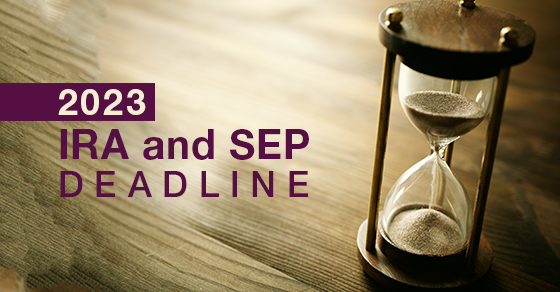

If you’re gathering documents to file your 2023 tax return and you’re concerned that your tax bill may be higher than you’d like, there might still be an opportunity to lower it. If you qualify, you can make a deductible contribution to a traditional IRA right up until the April 15, 2024, filing date and benefit from the tax savings on your 2023 return.
Who is eligible?
You can make a deductible contribution to a traditional IRA if:
For 2023, if you’re a joint tax return filer and you are covered by an employer plan, your deductible IRA contribution phases out over $116,000 to $136,000 of modified AGI. If you’re single or a head of household, the phaseout range is $73,000 to $83,000 for 2023. For married filing separately, the phaseout range is $0 to $10,000. For 2023, if you’re not an active participant in an employer-sponsored retirement plan, but your spouse is, your deductible IRA contribution phases out with modified AGI of $218,000 to $228,000.
Deductible IRA contributions reduce your current tax bill, and earnings within the IRA are tax deferred. However, every dollar you take out is taxed in full (and subject to a 10% penalty before age 59½, unless one of several exceptions apply).
IRAs are often referred to as “traditional IRAs” to differentiate them from Roth IRAs. You also have until April 15 to make a Roth IRA contribution. But while contributions to a traditional IRA are deductible, contributions to a Roth IRA aren’t. However, withdrawals from a Roth IRA are tax-free as long as the account has been open at least five years and you’re age 59½ or older. (There are also income limits to contribute to a Roth IRA.)
Here are two other IRA strategies that may help you save tax:
1. Turn a nondeductible Roth IRA contribution into a deductible IRA contribution. Did you make a Roth IRA contribution in 2023? That may help you in the future when you take tax-free payouts from the account. However, the contribution isn’t deductible. If you realize you need the deduction that a traditional IRA contribution provides, you can change your mind and turn a Roth IRA contribution into a traditional IRA contribution via the “recharacterization” mechanism. The traditional IRA deduction is then yours if you meet the requirements described above.
2. Make a deductible IRA contribution, even if you don’t work. In general, you can’t make a deductible traditional IRA contribution unless you have wages or other earned income. However, an exception applies if your spouse is the wage earner and you’re a stay-at-home parent or homemaker. In this case, you may be able to take advantage of a spousal IRA.
What’s the contribution limit?
For 2023 if you’re eligible, you can make a deductible traditional IRA contribution of up to $6,500 ($7,500 if you’re 50 or over).
In addition, small business owners can set up and contribute to a Simplified Employee Pension (SEP) plan up to the due date for their returns, including extensions. For 2023, the maximum contribution you can make to a SEP is $66,000.
If you want more information about IRAs or SEPs, contact us or ask about it when we’re preparing your return. We can help you save the maximum tax-advantaged amount for retirement.

